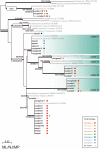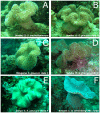Soft coral Sarcophyton (Cnidaria: Anthozoa: Octocorallia) species diversity and chemotypes
- PMID: 22272344
- PMCID: PMC3260304
- DOI: 10.1371/journal.pone.0030410
Soft coral Sarcophyton (Cnidaria: Anthozoa: Octocorallia) species diversity and chemotypes
Abstract
Research on the soft coral genus Sarcophyton extends over a wide range of fields, including marine natural products and the isolation of a number of cembranoid diterpenes. However, it is still unknown how soft corals produce this diverse array of metabolites, and the relationship between soft coral diversity and cembranoid diterpene production is not clear. In order to understand this relationship, we examined Sarcophyton specimens from Okinawa, Japan, by utilizing three methods: morphological examination of sclerites, chemotype identification, and phylogenetic examination of both Sarcophyton (utilizing mitochondrial protein-coding genes MutS homolog: msh1) and their endosymbiotic Symbiodinium spp. (utilizing nuclear internal transcribed spacer of ribosomal DNA: ITS- rDNA). Chemotypes, molecular phylogenetic clades, and sclerites of Sarcophyton trocheliophorum specimens formed a clear and distinct group, but the relationships between chemotypes, molecular phylogenetic clade types and sclerites of the most common species, Sarcophyton glaucum, was not clear. S. glaucum was divided into four clades. A characteristic chemotype was observed within one phylogenetic clade of S. glaucum. Identities of symbiotic algae Symbiodinium spp. had no apparent relation to chemotypes of Sarcophyton spp. This study demonstrates that the complex results observed for S. glaucum are due to the incomplete and complex taxonomy of this species group. Our novel method of identification should help contribute to classification and taxonomic reassessment of this diverse soft coral genus.
Conflict of interest statement
Figures






References
-
- Dinesen ZD. Patterns in the distribution of soft corals across the central Great Barrier Reef. Coral Reefs. 1983;1:229–236.
-
- Fabricius KE. Soft coral abundance on the central Great Barrier Reef: effects of Acanthaster planci, space availability, and aspects of the physical environment. Coral Reefs. 1997;16:159–167.
-
- Riegl B, Schleyer MH, Cook PJ, Branch GM. Structure of Africa's southernmost coral communities. Bull Mar Sci. 1995;56:676–691.
-
- Tursch B, Tursch A. The soft coral community on a sheltered reef quadrat at Laing Island (Papua New Gunea). Mar Biol. 1982;68:321–332.
-
- McFadden CS, Sánchez JA, France SC. Molecular phylogenetic insights into the evolution of Octocorallia: a review. Int Comp Biol. 2010;50:389–410. - PubMed
Publication types
MeSH terms
Substances
Associated data
- Actions
- Actions
- Actions
- Actions
- Actions
- Actions
- Actions
- Actions
- Actions
- Actions
- Actions
- Actions
- Actions
- Actions
- Actions
- Actions
- Actions
- Actions
- Actions
- Actions
- Actions
- Actions
- Actions
- Actions
- Actions
- Actions
- Actions
- Actions
- Actions
- Actions
- Actions
- Actions
- Actions
- Actions
- Actions
- Actions
- Actions
- Actions
- Actions
- Actions
- Actions
- Actions
- Actions
- Actions
- Actions
- Actions
- Actions
- Actions
- Actions
- Actions
- Actions
- Actions
- Actions
- Actions
- Actions
- Actions
- Actions
- Actions
- Actions
- Actions
- Actions
- Actions
- Actions
- Actions
- Actions
- Actions
- Actions
- Actions
- Actions
- Actions
- Actions
- Actions
- Actions
- Actions
- Actions
- Actions
- Actions
- Actions
- Actions
- Actions
- Actions
- Actions
- Actions
- Actions
- Actions
- Actions
- Actions
- Actions
- Actions
- Actions
- Actions
- Actions
- Actions
- Actions
- Actions
- Actions
- Actions
- Actions
- Actions
- Actions
- Actions
- Actions
- Actions
- Actions
- Actions
- Actions
- Actions
- Actions
- Actions
- Actions
- Actions
- Actions
- Actions
- Actions
- Actions
- Actions
- Actions
- Actions
- Actions
- Actions
- Actions
- Actions
- Actions
- Actions
- Actions
- Actions
- Actions
- Actions
- Actions
- Actions
- Actions
- Actions
- Actions
- Actions
- Actions
- Actions
- Actions
- Actions
- Actions
- Actions
- Actions
- Actions
- Actions
- Actions
- Actions
- Actions
- Actions
- Actions
- Actions
- Actions
- Actions
- Actions
- Actions
- Actions
- Actions
LinkOut - more resources
Full Text Sources
Miscellaneous

